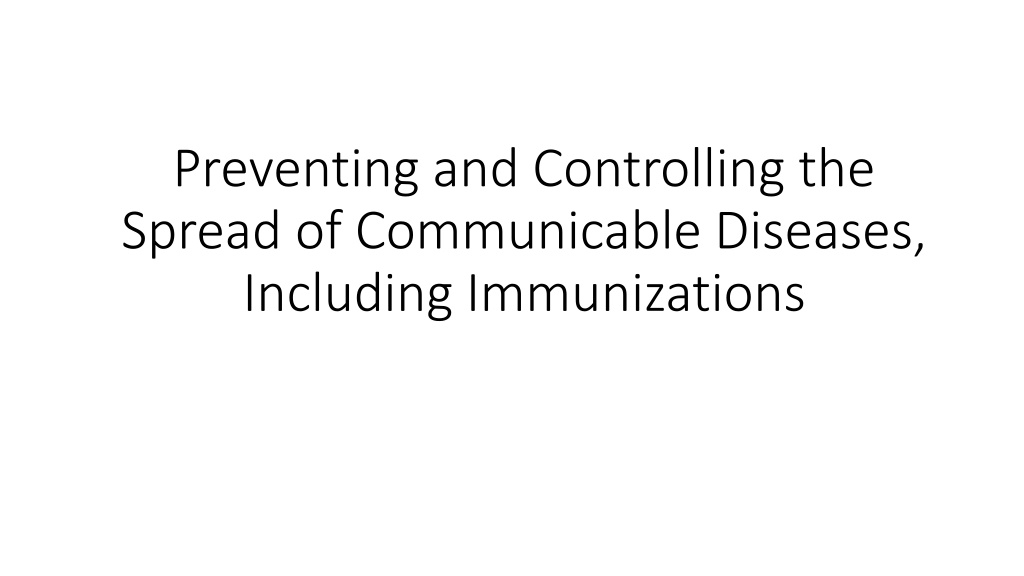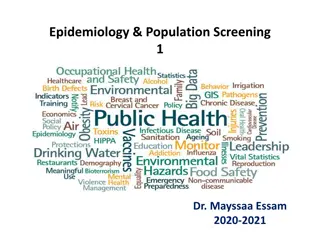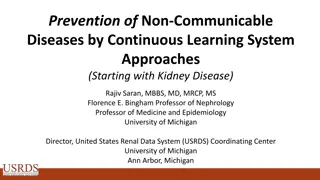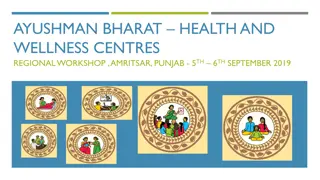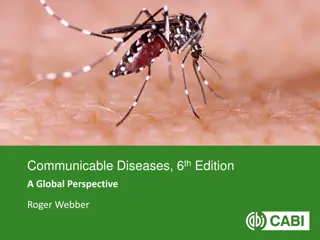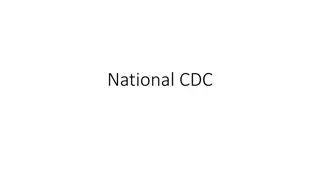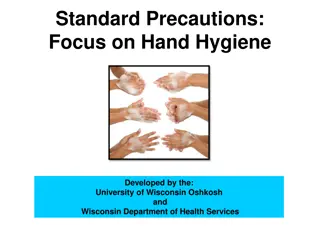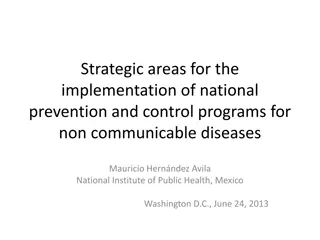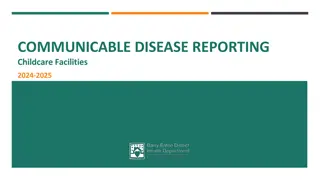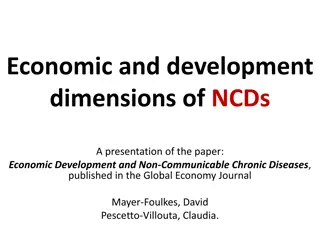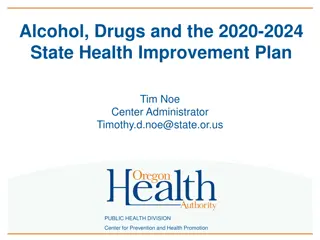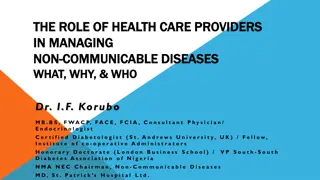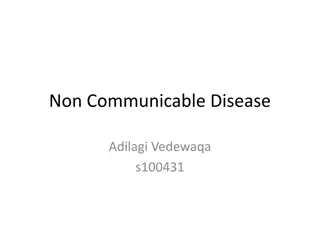Understanding and Preventing Communicable Diseases
Communicable diseases, also known as contagious or infectious diseases, are caused by germs such as viruses, bacteria, fungi, and parasites. These illnesses spread from person to person through various means like body fluids and can have different treatment approaches. It is essential to know how these diseases spread and the types of germs involved to effectively prevent and control their transmission.
Download Presentation

Please find below an Image/Link to download the presentation.
The content on the website is provided AS IS for your information and personal use only. It may not be sold, licensed, or shared on other websites without obtaining consent from the author. Download presentation by click this link. If you encounter any issues during the download, it is possible that the publisher has removed the file from their server.
E N D
Presentation Transcript
Preventing and Controlling the Spread of Communicable Diseases, Including Immunizations
Medical Home Performance Standard 1302.42 1302.80 (a) Minimum Standard 746.603(3) Policy Statement: UTRGV-PSJA ISD-EHS-CCP Program children must have a medical home within 90 days after the child attends the program. A medical home includes a primary care physician, dentist and or specialist with the corresponding well baby exam, oral exam, immunizations, and tuberculosis screen. UTRGV-PSJA ISD-CCP Program will assist families in accessing and maintaining an up to date medical and dental care. The enrolled pregnant woman will have continuance accessible health care within 30 days.
What Are Communicable Diseases? What Are Communicable Diseases? They are illnesses that spread from one person to another. They are also called contagious or infectious diseases. Communicable diseases are caused by germs and tiny bugs. The germs are so small that they can only be seen with a microscope, not with the naked eye. Aggregation in groups can increase and decrease the risk of spread of communicable disease.
The germs and bugs are categorized as: viruses (e.g., "colds," chicken pox, hepatitis A & B, HIV), bacteria (e.g., "strep," tuberculosis), or fungi (e.g., ringworm, thrush), and parasites (e.g., giardia, pinworms, scabies, head lice). Illnesses caused by bacteria, fungi and parasites always need medical evaluation and antibiotic treatment. Many illnesses caused by viruses are mild and go away on their own, but some need medical evaluation and treatment.
Types of germs Virus People often get better on their own. There is limited treatment, other than rest and control of symptoms Bacteria Often need to be treated with antibiotics Fungus Often on surfaces of body and can be treated with creams or oral medication. Parasite Typically cause diarrhea Often need to be treated with antiparasitic medications
How Do Communicable Diseases Spread? Germs that cause communicable diseases are found in and on people, animals, food, water, air, and dirt. Most of the germs are carried in human "body fluids" - blood, mucus, saliva, vomit, stool, urine, and discharges from the eyes and skin lesions. Most communicable bugs are carried on the skin and hair.
Communicable diseases can be categorized by the way they spread: Respiratory diseases (e.g., colds) affect the head and chest. Gastrointestinal diseases (e.g., infectious diarrhea) affect the stomach and intestines. Dermatologic diseases (e.g., ringworm) affect the skin and hair. Blood-borne diseases (e.g., hepatitis B) affect the entire body.
How Pathogens Enter the Body Direct contact Indirect contact Airborne Vector-borne
Recognize & Managing Communicable Diseases Recognizing and managing Communicable Diseases involves a partnership among Staff, Families and Health Professionals. Communication among Staff, Families and Health Professionals plays a key role in preventing & managing Communicable Diseases.
The Role of staff is: Observe children for signs of Illness. Care for ill children until they can be sent home. Document Signs, Symptoms and Actions taken. Discuss with parents their child's condition, whether he/she is too sick to attend, the need for Medical Evaluation and Treatment, and when they are able to return.
Procedures for Immunizations: l. deficient immunization records will not be allowed to attend school. Necessary arrangements will be made to assist the parent in acquiring the necessary immunizations as needed. (Minimum Standard 746.613) Children must have all immunizations up to date prior to the first day of school. Children with 2. In the event a child has his/her birthday during the school year, the parent will be sent a Health Notice. The parent will have thirty (30) days in which to comply with the immunizations. All efforts made to assist the parents in acquiring the needed immunizations for their child will be documented in Child Plus and Family Contact Notes. 3. health fairs, establishing clinics or referrals to local health department. Efforts to assist families throughout the school year in order to update immunizations will include
Cont. Procedures for Immunizations: 4. Immunization schedules are to follow the Texas Department of Health Services requirements and comply with the Minimum Standards of the Texas Department of Protective and Regulatory Services. a. Affidavit request for exemption from immunizations is available at https://core.quest.dshs.tesxas.gov 5. In the event parent/guardian chooses to not immunize their child for religious or personal beliefs, a notarized affidavit is required and kept in family file. This form will be reviewed and discussed annually with parent/legal guardian.
Immunizations Staff and parents should consult their Health Care Provider about the following Immunizations: Polio, Measles, Mumps, Rubella, Tetanus, Diphtheria, Hepatitis B, Influenza, Pneumococcal, and Chicken Pox. Note: New Immunizations can become available at any time, consult your Local Public Health authorities to learn the most current recommendations or log on to www.cdc.gov/vaccines.
Preventing the Spread of a Communicable Disease It is important to ensure that you receive vaccinations for Communicable Diseases. Stay current with Flu shots by receiving one annually. This will allow your body the Antibodies necessary to combat these Diseases should you ever become infected by them.
Tuberculin (TB) Tuberculosis (TB) is a Communicable Disease that can cause Cough, Pneumonia, Fevers, Weight Loss, and even Death. Young children, seniors, and people with health problems are especially at risk. TB spreads by Coughing. The infection enters the lungs and may cause no symptoms for years. One third of the world s population is infected with TB. 2 million deaths a year.
Tuberculin (TB) Transmission of Tuberculosis is a three step process: Transmission of bacteria Establishment of infection Progression to disease
TB Infection versus Disease Infection (Goal= to prevent future active disease) TB infection No disease Not sick Not infectious Active TB (Goal =treat to cure, prevent transmission) TB infection which has progressed to TB disease Sick Infectious
Diagnosis of TB Disease:Symptoms Pulmonary TB Disease Coughing Pain in the chest when breathing or coughing Coughing up sputum or blood General TB Disease Weight loss Fatigue Malaise Fever Night Sweats
Communicable Disease Reporting Policy EHS-UTRGV will report all communicable disease in keeping with local, tribal and state regulations
Prevention of Communicable Diseases More often, preventing Communicable Disease is accomplished through attention to Hygiene, Proper Lifestyle and General Cleanliness.
Preventing the Spread of a Communicable Disease Cover all open wounds. Dispose of all used tissues by placing them into a sealed plastic garbage. Wash commonly-used items, such as toys and eating utensils, using hot water and soap.
Preventing the Spread of a Communicable Disease Maintain a strong immune system by incorporating proper nutrition, rest and daily exercise into your lifestyle. Do not share drinks, toothbrushes or eating utensils with other individuals.
Children Children in Large group settings-are more prone to Infection Germs spread more easily in a group setting. Young children have not yet developed natural resistance. Several Communicable Diseases are contagious before symptoms appear, making it difficult to prevent their spread.
Catchinga Communicable Disease It means a Germ has invaded their body. Germs fear soap and water. Washing your hands well and often is the best way to beat these tiny warriors.
What is a Germ? In fact, Germs are so tiny that you need to use a microscope to see them. We may not know what hit us until we have symptoms (runny nose, cough, sore throat, fever, etc.) that let us know we've been attacked!
Disease Transmission Protective Equipment (gloves/masks) Personal Hygiene Practice (hand-washing) Engineering & Work Practice Controls Equipment for Cleaning & Disinfecting
Body Substance Precautions Body Substance Precautions-refer to the consistent use of barrier methods to prevent direct contact with the body fluids of another person. Gloves are worn to prevent contact with non-intact skin, moist mucous membranes, and body fluids; masks and eye protection are worn when there is a chance of splashing body fluids into the eyes, nose or mouth; gowns are worn if there is a chance that clothing may become soiled with body fluids.
Hand Washing Diligent hand-washing is perhaps the easiest and most effective method of Preventing Communicable Disease. Numerous Flu-causing Germs and Viruses are passed into the nose, mouth, eyes or ears via the hands that can be removed through soap and water.
Hand Washing Germs and Viruses commonly reside on public objects (doorknobs, handrails, counters) as well as household objects, pets, appliances and certain foods. Wash your hands according to the Hand Washing procedure.
Cleaning & Disinfecting Surfaces is one of the most important ways to ensure that communicable diseases are not spread. Proper cleaning reduces the number of germs or microorganisms available to cause illness or inction. 4 step process 1. Wash with water and soap 2. Rinse with clear water, 3. Soaking in or spraying on a disinfecting solution (2minutes) 4. Allow the surface to air-dry.
Protecting Children from Disease Transmission The following needs to be sanitized: Mouth toys Sleeping equipment Potty chairs Table tops Diapering tables Water tables
Controlling Infection Places/Environment Facility Design Enough space to prevent crowding Surfaces easily cleanable Separation of food areas from toileting and diapering areas Enough flushing toilets and well-designed diaper- changing stations
Protecting yourself from Disease Transmission Exposure Control Plan: Exposure Determination Schedule & Methods for implementing OSHA Standards Procedures for evaluating exposures
